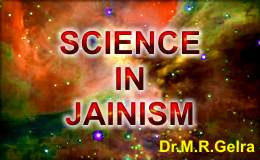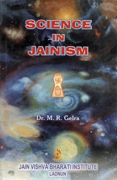
Many of the deeper problems of nature have a long history of thousand of years. This is certainly evident to the philosophers and thinkers of different parts of the world who tried to explore the nature of the universe. During these years theoretical physicists have taken the lead in exploring the largest of the large and the shortest of the short of this universe. Many current ideas about the cosmos, space and time have been presented by the scientists, which seem to have precise details in the ancient (300 B.C.) Jain Agamic literature. Jain texts define space as 'space accommodates all substances' or 'it is the location of all substances'. Substance means an entity, which has the property of permanence through change and has qualities and modes.
Substances or realities are six in number, which constitute the universe: The soul, matter, a medium, which facilitates motion, a medium that facilitates rest, space and time. Other than matter, rest of the five substances are non-material in nature.
Jains believe that Space is infinite but the universe is finite. The finiteness of the universe is not due to any limit of space but due to the limit of the twin substances 'the medium of motion and the medium of rest'. In the absence of these twin substances, matter and soul can neither move nor can they occupy any part of the space for stop. Though, motion and rest are the two states, which are characteristic of matter, but motion and rest of the matter require an aid of the medium.
In the field of science, while studying the propagation of light it was suggested that there was a substance called the 'ether' that was present everywhere, even in 'empty' space which provides aid to motion. It was proposed that light waves should travel through ether as sound waves travel through air. But in 1905, Einstein pointed out that the whole idea of ether was unnecessary.
The Jains did not conceive any entity like ether but proposed the existence of twin substances in space which are devoid of empirical qualities (non-material) continuous and pervading the whole occupied universe. They have no form. They do not initiate motion or rest of matter but they facilitate motion or rest. These twin substances are found only in the occupied universe, hence no matter can move out of Universal Space into the acosmic space.
Jains stand alone amongst the other ancient philosophies in believing these twin substances, which are known as Dharamastikaya (medium of motion) and Adharmastikaya (medium of rest). The finite portion occupied by these twin mediums in space causes the universe to be finite. Jains have specially mentioned that a ray of light or even the wave of sound cannot travel without the medium of motion.
During last fifty years, a tremendous effort has been made by scientists to know about of the nature of the universe. Einstein's theory of relativity and the concept of entropy have suggested that he Universe is finite. Arthur Eddington stated that the Universe is also unbounded. He explained that the universe is indeed finite, limited as it is by the space it takes up, but the space does not limit it with boundaries. This concept left room for the possibility of the existence of something beyond this finite and unbounded universe of space.
Though Jain cosmology treats the identity of the medium of motion and the medium of rest independent of the substance space, the unit-points of the twin substances occupy the same space as that of the space points. Sometimes, this causes confusion. Jains, therefore, termed the unoccupied space as Aloka (acosmic space) and the occupied space as Loka.
The finiteness of the universe has also been supported by Newton's law of gravity, which states that every body attracts every other body with a force that is proportional to the mass of each body. Stephen Hawking says that it is gravity that shapes the large-scale structure of the universe.
We find that when we combine quantum mechanics with general relativity, space and time together form a finite, four-dimensional space without boundaries. Conclusively, it may be said that the finiteness of the universe has been dealt within Jain Cosmology and in modern physics. Jains concept regarding the finite universe is much more clear as Jains conceive the presence of unoccupied space (Aloka) all round the universe. This concept of Aloka (acosmic space) is helpful in explaining the unboundedness of the universe.
In the Jain literature, we find a unique description of the eight-point centre (Ruyaga Padesa) of the Universal space. The concept of eight-point centre for the universe suggests that there is likelihood of the change of centre along an oblate sphere (like a pressed water drop). The oblate sphere intersects the edges of the eight Ruyaga Padesa, which lie near the geometrical centre of the universe. These Ruyaga Padesas are comparable to the udders of a cow. The concept of eight-point centre of the universal space directs to idea of the shifting of the centre, whenever needed. For such a universe where the centre may shift, the universe cannot have boundaries.
Jain scriptures provide one more evidence for the finiteness of the universe. Out of the six realities of the universe, soul is one of them, which has a unique property of contraction and extension. When the soul fully expands itself during kevali samudghat it pervades the whole Universal space. It shows the limitation of the Universe in the space. It is worthwhile to know that the medium of motion, medium of rest, the maximum extension of soul have their smallest of ultimate units equal to the ultimate units of the Universal space. This limit of the Jain cosmological theory, maintains the Universe stable.
 Dr. Mahavir Raj Gelra
Dr. Mahavir Raj Gelra

